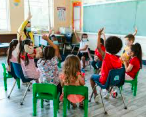Keeping preschoolers engaged during lessons can be both joyful and challenging. At this age, children are full of energy, curiosity, and a desire to explore the world around them. To capture their attention and nurture a love of learning, educators and caregivers need creative and flexible strategies that match young learners’ developmental needs.
Make Learning Hands-On and Active
Preschoolers learn best by doing. Activities that involve movement, manipulation, and real-world objects help children stay focused and excited. Whether it’s using blocks to learn math, finger painting to explore colors, or dramatic play to understand emotions, hands-on experiences turn abstract concepts into concrete learning.
Use Stories and Songs to Teach
Songs, rhymes, and storytelling can transform lessons into memorable experiences. They engage multiple senses, boost language development, and make it easier for children to recall new ideas. Educators can use music to introduce new topics, guide transitions, or calm the class, while stories can bring lessons to life with characters and adventures children love.
Keep Lessons Short and Varied
Young children have limited attention spans, so short bursts of activity are more effective than lengthy lessons. Rotate between activities—like a movement break after story time or an art project following a science lesson—to keep energy high and interest steady.
Involve Children in the Learning Process
Giving preschoolers choices empowers them and increases their engagement. Letting them pick the next activity or choose materials allows them to feel ownership over their learning. Involving them in setting up or cleaning up also builds responsibility and keeps them active.
Connect Lessons to Real Life
Preschoolers are naturally curious about the world around them. Link lessons to everyday experiences—talk about weather during outdoor play, count objects during snack time, or explore nature during a walk. When children see how learning applies to their daily lives, they stay more interested and involved.
Create a Supportive and Joyful Environment
A positive classroom atmosphere encourages children to take part and try new things. Praise effort, celebrate small successes, and keep the mood light and encouraging. When preschoolers feel safe and supported, they are more willing to participate and explore.
Final Thoughts
Keeping preschoolers engaged doesn’t require complicated plans—just thoughtful, child-centered approaches that recognize their need for movement, variety, and joyful exploration. With patience and creativity, every lesson can become a playful and meaningful learning opportunity.


